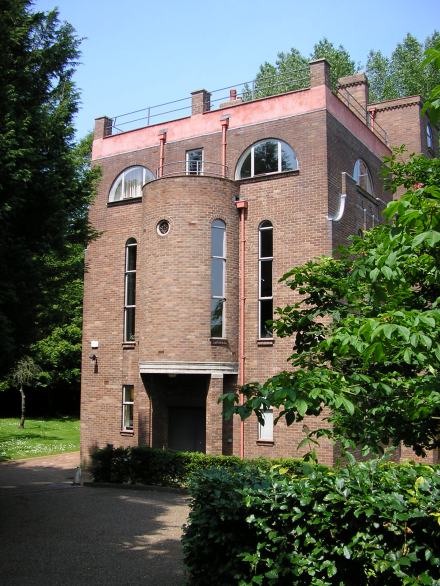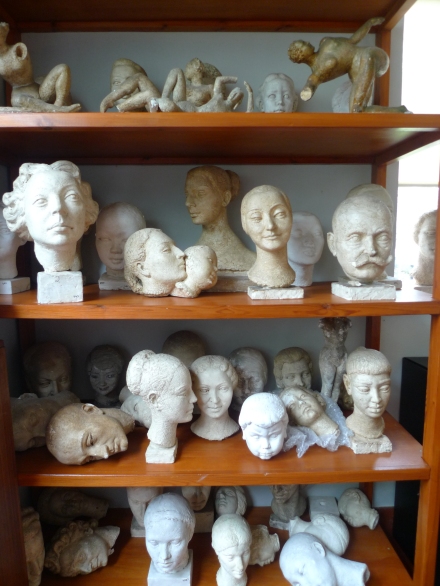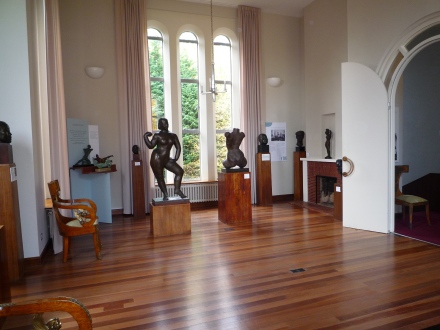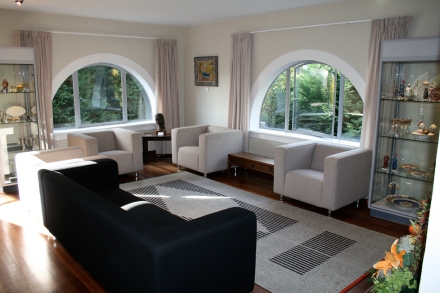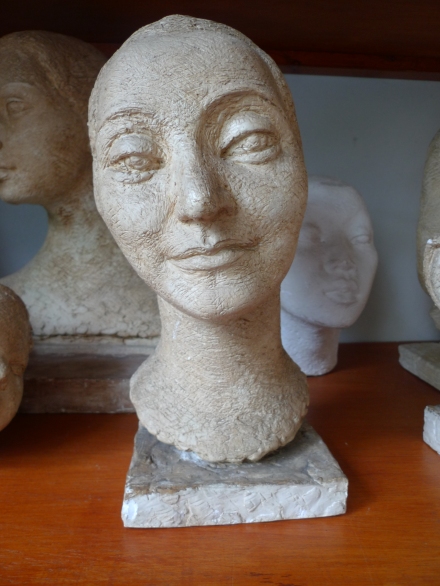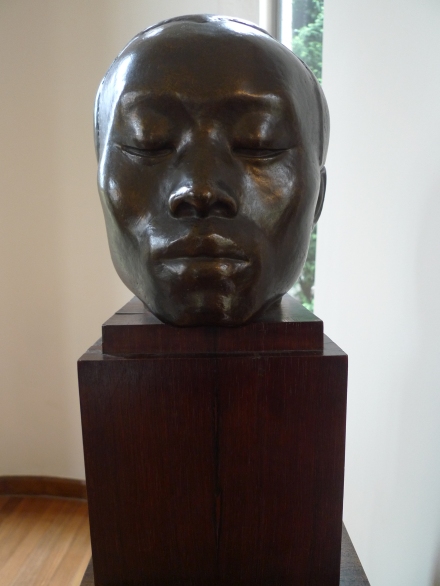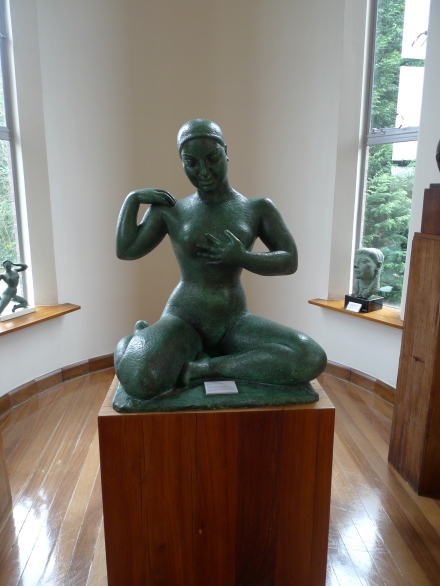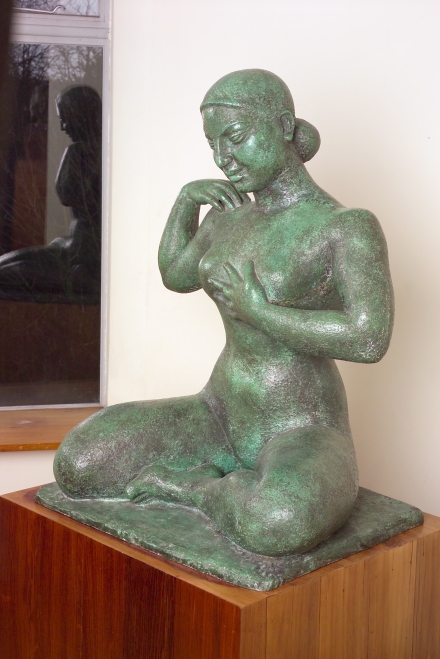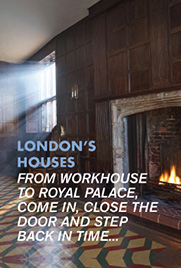7 Kingston Vale, London SW15 3RN
Tel: 020 8417 5515
http://www.dorichhousemuseum.org.uk
Nearest transport: Kingston Rail then bus 85 or Putney Rail then bus 85 Woodview Close stop
Open: monthly open days, usually Fridays, 11.00-16.00, tours at 11.30 and 14.30, booking advised
Admission: £4/£3/under-16s free
Wheelchair access: very limited
‘Beautiful houses in which hospitality can be given to friends have always been among the most important foundations of civilised life.’
Dora Gordine, interview for BBC Radio, 1950
Dorich House takes its name from a conflation of the first names of its owners – sculptor Dora Gordine (1895–1991) and collector of Imperial Russian art and academic Richard Hare (1907–1966) – who designed it together shortly before their marriage in 1936 and lived here until their deaths. Dorich House is for the most part the creation of a woman: Hare’s family fortune may have provided the means, but it was Gordine who supplied the vision, and it was her personality and the demands of her working life that seem to have shaped its spaces.
Gordine was born in Libau in Latvia to a moderately wealthy and cultivated family. By 1920 she had arrived in Paris, where her exotic status as a Russian émigrée enabled her to make connections in the bohemian and art worlds. Though she had no formal training, she exhibited sculpture at the Salon des Beaux Arts in 1925 and the following year was invited by the artist Pom Pom to exhibit at the Salon des Tuileries. Two years later she held an extremely successful solo show in London (the Evening Standard dubbed her the ‘Girl genius sculptor’) and as a result was invited to produce six heads representing the Malay Peninsula’s different races for a new municipal building in Singapore. Here she married Dr G H Garlick, an English physician to the Sultan of Johore, and through his connections began to receive the commissions for bronzes, paintings and drawings of the great and good that were to remain her bread and butter throughout her career.
The marriage was short lived. Aristocrat Richard Hare had bought one of Gordine’s pieces in London in 1928 and stayed with the Garlicks as a houseguest during his tour of south-east Asia in 1933. By the following year Gordine and Hare were writing letters in which they planned to build a London house together.
The result – Dorich House – is an extraordinary mix of fortress, warehouse and extruded, over-tall Palladian villa. Built in brick, it has double-height triple windows or matching blind arches on either side of a projecting tower on the east and west elevations, surmounted by a clerestory of semicircular windows on the top floor and a roof terrace. The south elevation has a semicircular bay supported on columns and to the north glazed horizontal bands of windows draw light into the studio spaces. Though Gordine was well versed in modernist architecture (while in Paris she had commissioned her neighbour and friend Auguste Perret, the foremost pioneer of reinforced concrete, to build her a studio), Dorich House is no slave to any style or movement and is modern primarily in its determination to reinvent living conditions to suit the needs of its occupants.
Visitors enter a hallway with rich red carpets over the polished wood floors that are a feature of the house – Gordine carefully selected and cared for the wood and insisted that all visitors don a pair of the slippers she kept for the purpose. As elsewhere in the house, divisions between the spaces are marked by dramatic arches that frame vistas.
The tour begins in the ground-floor studio used for plaster casting – hence the tiled sink, ceramic floor and hoist to take pieces up to and down from the modelling studio above. Gordine rarely worked from sketches but instead moved straight from metal armature to plaster, declaring that the process of making mistakes and reworking was vital to creation. Initially she would spend whole days talking or just being with her subjects so she could ‘imagine what they are like inside and bring out their inward feelings, and then put it in a form’. Many of her sitters, including the actress Siân Phillips, were surprised by the amount of time they had to devote to the process – often as much as four weeks of sittings, from 10am to 5pm.
Among the many busts of actors, dancers, writers, television personalities and Hare’s aristocratic and wealthy connections is a plaster cast of Edith Evans. The actress, then aged 50 and embarking on an affair with Michael Redgrave, an actor 20 years her junior, also modelled for a nude standing bronze, now at the bottom of the stairs. Arms raised behind her head to expose her body fully and face turned to one side as if the viewer is of no interest to her, she exudes the sense of a woman who is completely comfortable with both her body and her self. Evans was to say in interviews that modelling for Gordine was better than therapy: ‘Posing in the nude… has taken away all my inhibitions… It gave me a completely new idea of myself.’
On the first floor above the plaster-casting studio is the modelling studio, with a dais at one end so sculptures could be viewed from different angles. With metal-framed (originally Crittall) windows running the full length, and Richmond Park stretching beyond, the impression is of being in a tree house. Beside the dais is the plaster cast of Power, a 1960 commission for Esso that shows a refinery construction worker lifting a metal girder into place. The sculpture is intended to celebrate strength and work, but in fact the inspiration was flamenco dancers – and indeed the worker’s neat boots, muscular legs and bottom, narrow waist and outflung arms are more dancer than builder. On the landing is Crowning Glory (1947), a statuette commissioned as a trademark for Eugène Permanent Wave, who placed hundreds of reproductions in salons that used the company’s products.
The double-height gallery opposite is a temple to Gordine’s art – and indeed the tall, narrow triple windows (intended to focus the gaze on the art by minimising the view), and the curved apse at the southern end, subtly evoke ecclesiastical buildings. Though Gordine had no other gallery or dealer through which to sell her work, photographs show the room as a mix of showcase salon and domestic space, with Gordine sitting with her dog on one of two large, accommodating art deco armchairs placed on either side of the fireplace.
Among the many sculptures are several of the heads from the 1930 Singapore commission. Dyak/ Headhunter/ Man (1931), which was exhibited at the 1951 Festival of Britain, and Torso/ Walking Male Torso (1927) are two of the few male figures in her oeuvre. The headless female Smiling Torso (known to Gordine and her friends as ‘Laughing Buttocks’) does indeed seem to smile – and like the two male torsos has a distinctly erotic charge.
The relatively modest second-floor apartment was Hare and Gordine’s living space, supplemented by a roof terrace where the couple and their friends would eat, hold parties and occasionally sleep. Above the gallery are the drawing room and dining room, lit by large semicircular windows and joined by a circular door inspired by the ‘moon gates’ of Chinese and Japanese gardens. The fireplaces – simple concrete lintels above slender bricks – are near copies of Perret’s designs for Gordine’s Paris apartment and the curtains were Duncan Grant’s 1932 ‘Clouds’ fabric.
Hare – whose workspace was a relatively small study on the south side of the ground floor that is now an office – was Director of the Anglo-Soviet Relations Division of the Ministry of Information during the Second World War and then became a lecturer and eventually Chair of Russian Literature at the London School of Slavonic and East European Studies. He was also a passionate collector of Imperial Russian art – in the belief that building a collection would help the British to understand the country and its culture – and wrote several books on Russian art and literature as well as translating works by Turgenev and others. Some of his collection was stolen from the house in 1988 and some sold to fund its restoration. However, you can still appreciate cabinets of porcelain in the drawing room (including extraordinary bowls made in the Imperial era but decorated with Bolshevik agit-prop messages) and wonderful 18th-century icons in the bedroom. What was once a dressing room is now crammed with an ornate dining suite copied from designs for the Winter Palace in St Petersburg, possibly passed down through Gordine’s family.
Photographs of the couple show them enjoying domestic life: eating together on the roof terrace, or Gordine in her apron watching Hare proudly manipulating an electric floor polisher in the drawing room. Gordine in particular is extraordinarily arresting: a doll-like figure with stylised kiss curls flattened on each cheek, dramatically arched eyebrows and large, heavily lidded eyes that resemble those of her sculptures and portraits. Above the fireplace in the drawing room is a 1929 portrait she made of Hare which seems to draw out his femininity – full lips, exaggeratedly large eyes and arched eyebrows (not dissimilar to her own), and soft skin. Both were dedicated to the aesthetic pursuits of making art and writing and their marriage appears to have been happy and fulfilling. Certainly Gordine was devastated by Hare’s death, describing the loneliness that followed as ‘worse than anything under the sky’.
Gordine continued to live at Dorich House for the next quarter century, but her career as a sculptor more or less ground to a halt – whether because the networking, which had brought her so many valuable commissions, diminished, or because she had lost Hare’s presence, which had become the armature that supported her creativity. Her style had not really developed as she grew older in comparison with contemporaries such as Barbara Hepworth, and perhaps the house in Kingston and a social circle that included few artists had become something of a safe retreat. Whatever the case, we can be glad that this enigmatic partnership produced the ‘foundation of civilised life’ that is Dorich House and its contents.
This is an extract from the latest edition of London’s Houses by Vicky Wilson, which reviews all the major and minor London Houses open to the public. The new edition is now in full colour.
Available from our website at £2.00 off the RRP (recommended retail price)

